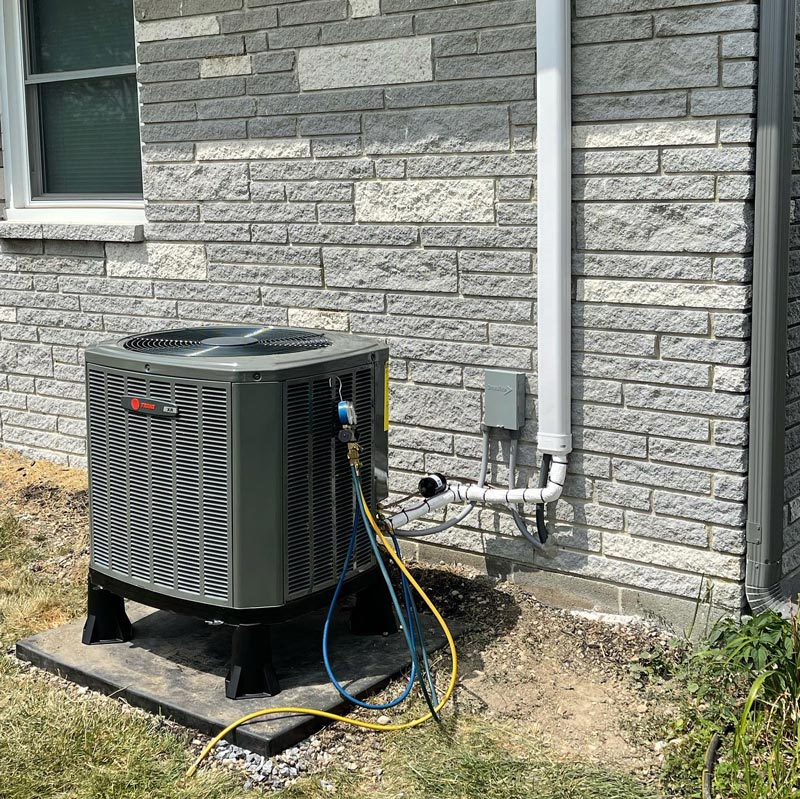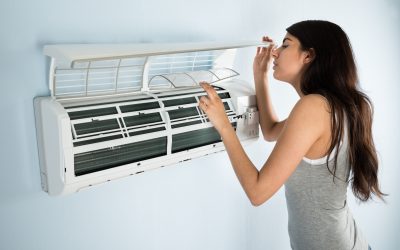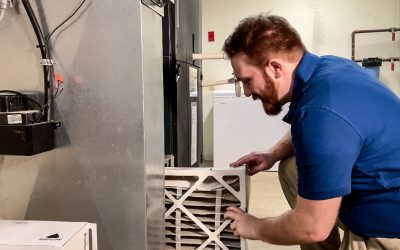Central air or ductless mini-splits: when it comes to cooling your home this summer, these two are the go-to solutions for Pennsylvania’s heat. But what exactly are they, and what is the difference between them? How do you know which one is right for your home?
Central air systems are standard in modern homes. A single indoor unit pushes cold air through a series of ducts, delivering the cooled air to each room. By contrast, a ductless mini-split is often the choice for a single area. Called a mini-split because one part works with the indoor air while the other part is an outdoor compressor, these units are perfect for cooling a single room like an attic or when ductwork is not an option, like multi-unit or older homes.
Knowing which type of system would be best for your home requires you to evaluate the needs of your home. Do you have large spaces or pre-existing ductwork? Do you need zoning for different areas of your house?
The proper system for your home saves energy and keeps the air comfortable – both in temperature and humidity. Working with professionals like Leckron’s technicians ensures you receive the most up-to-date advice from experts specializing in HVAC systems.
A general understanding of central air versus ductless mini-splits prepares you for your consultation, so you can ask more specific questions regarding your home’s needs.
Central Air Systems
Central air systems have an indoor unit with a blower that pushes cooled air through the ducts and into various rooms in the home. This indoor unit is often hidden in the basement, garage, or utility closet.
The condenser, which is the outdoor unit, houses the compressor, propeller fan, circuit board, and heat exchange coil. You typically find this unit at the back or side of the home. Its job is to pump refrigerant to and from the indoor unit and remove heat from your home.
Most modern homes have appropriate ductwork installed. Generally, areas like attics, garages, add-ons, or homes predating AC need a different solution. In these situations, central air may not be the best option.
How central air systems work
Let’s pretend you want to keep your home at 68 degrees. When your thermostat registers above 68, the furnace will kick on and send cold air throughout the house. The blower motors inside the condenser and indoor unit kick on, pulling warm air into the ductwork and cooling it with the evaporator coils. The cool air is sent back to the rooms through the return vents. The refrigerant that has now absorbed the heat from the air is pumped to the condenser, which removes the heat from the refrigerant. The refrigerant is then sent back into the home, and the process repeats until the home reaches 68 degrees again.
Both pulling in the hot air and returning the cooled air, the system works through a series of ducts. If a home does not have ductwork, this functionality comes at a high cost. However, the upside to central air is its ability to cool large spaces and how effectively it does so, and most houses today come with ductwork ready to go.
Advantages and disadvantages of central air systems
Like all things in life, knowing the advantages and disadvantages generates the best decision. This insight is especially significant when deciding between central air or a ductless mini-split.
Advantages of Central Air
- Great for large spaces
- Use a network of ducts hidden inside the walls
- Effective at cooling larger areas
- Sound investment
- Often pre-installed in modern homes
- Only one indoor unit is necessary to cover all areas of your home
- A single thermostat controls the entire system
- Lower system cost (not including ducts) – running about $3000-$15000 for a system
Disadvantages of Central Air
- Expensive to install ductwork if not already present
- Lower energy efficiency than some ductless systems
Factors to consider when choosing a central air system
With something as large and potentially expensive as central air, consider how it fits within your situation. Evaluate these factors to stay in the land of satisfaction and far away from buyer’s remorse.
- Comfort & Reliability
What’s important to you in terms of systems? Does your unit need to both heat and cool? Do you want a constant airflow? Are you upgrading your home to smart devices (LINK SMART HVAC ARTICLE HERE) and prefer an HVAC system that matches?
Take some time to read reviews on models to find one with solid reliability and few breakdowns. Pay attention to the EPA indoor air quality scores. At Leckron’s, we spend days in and out working with HVAC systems and can recommend reliable units for your price point.
- Efficiency & Capacity
Look for Energy Star-certified models. These units come with ratings alerting you to their efficiency. There is no reason to throw money down the drain – especially when you just shelled out for a new unit.If your space is too large or small for your unit, it wastes energy. The BTU rating provides clues to the capacity your unit can handle. Central air is an excellent choice for a larger home or space, but it may not be the most energy-efficient if you only need a small space cooled.
- Thermostats
Consider if your new system works with your current thermostat. If changing to a programmable thermostat, check if the unit will work with it. Now would be a great time to look into the money-saving options of a smart thermostat to help with energy bills and unnecessary wear and tear of your central air unit. - Cost
The initial cost of a central air system is only one part of this evaluation. If you need ductwork in your home, the price tag for installing a central air system is quite steep. However, if your home is a recent build, you likely already have all the ductwork necessary.
Past this, factor in a plan that includes regular maintenance to ensure your system runs correctly and issues are addressed promptly. These plans keep your unit running effectively, decreasing overall breakdown costs and energy bills.
Ductless Mini-Split Systems
Like central air systems, ductless mini-splits supply cool or warm air to rooms. However, unlike the central air unit, it does not deliver to all the rooms or use ducts to provide the air. Instead, one or more indoor air handlers and a single outdoor compressor/condenser work together.
Each indoor air handler unit works in a single room. An outdoor compressor unit may have the option to have many air handlers running off of it. A compressor can run between four and eight air handlers.
Explanation of ductless mini-split systems
Ductless mini-split systems work as their name implies – without ducts. The indoor air handler and outdoor condenser split the responsibility of cooling the air.
With this system, you generally see the indoor air handler on the wall, floor, or ceiling of the room it is cooling. A small fan inside the unit pushes the cooled air into the room.
But how does it cool the air? The process is similar to a central air unit. The indoor unit contains coils cooled with refrigerant. The warm air is sucked into the air handler and passes over the coils, leaving cooled air to be pushed back out into the room. The refrigerant then travels through copper tubing to the outdoor condenser unit, where it releases the heat. The cooled refrigerant travels back to the indoor air unit, and the cycle continues.
Advantages and disadvantages of ductless mini-split systems
Like central air systems, it is wise to review the advantages and disadvantages of a mini-split system before purchasing. While some features ring true for either unit, others are unique and prove to be a swaying point in purchasing decisions.
Advantages of Mini-Split Systems
- Great for small spaces, room additions, and converted rooms
- Works without the use of ducts
- Zoned controlled for individual preference on temperature
- Energy efficient
- Perfect for older home without ductwork
- Can lower energy bills
- Flexible installation
- Less expensive to install
Disadvantages of Mini-Split Systems
- More visible inside the home
- More expensive to install than central air in a home that already has ductwork
- Less effective at filtering indoor air – may result in lower air quality
- Large spaces or extreme climates are not conducive to mini-split systems
Factors to consider when choosing a ductless mini-split system
Before installing mini-splits for your home, consider these factors and how they work within your home, budget, and family.
- Efficiency & Capacity
Mini-split systems are more energy-efficient than central air, as they do not use ducts and are less prone to energy loss. Furthermore, they can be zoned to only heat and cool specified rooms.They work best for smaller areas and rooms. If you have large rooms, these may be less effective. Likewise, they are not best suited for extreme temperatures.
- Installation
Because there is no need for extensive ductwork, mini-splits are less invasive when installed. An outdoor unit connects to indoor units with wiring. These indoor units are necessary for each room needing cooled or warmed air. - Cost
Initial upfront costs depend on your home and can run anywhere from $1,000 to over $10,000. Because of the ability to zone and decrease heat loss, ductless mini-splits may be less expensive to run as they do not have the heat/cooling loss of traditional central air systems. Bonus savings: look for tax credits or rebates to offset costs. - Indoor Air Quality
Because mini-splits do not use ducts, there is less concern about allergens, dust, mold, and dander moving through the home. Ductwork is notorious for accumulating dirt and debris over time. Going ductless means you no longer need to worry about allergens or mold building up in the ducts.
How to Choose the Right System for Your Home
Now that you have information on both types of systems, how do you know which is best for you?
Assessment of your home’s needs
Take an objective look at your home’s specific needs. It can be challenging to determine what constitutes “large” versus “small” or which would provide the most efficient system for your home.
Leckron’s professionals are happy to evaluate your home and the unit currently in place. We will recommend which system provides the best options for you. With tax incentives, rebates, specials, and financing, the system your home needs may be within reach. Consider the following factors and speak with a professional who can help guide your decision.
Determining the right system size
As mentioned, trained professionals are your best bet when determining which system is the best. They understand how the systems work in real-time, have experience with various situations, and understand the load each system can handle.
As a basic rule of thumb, for a mini-split system, use a calculation of 20 BTU per square foot. For example, if you have a 1000-square-foot home, you would take 1000 x 20 and get the 20,000 BTU output needed. If there is not adequate airflow to the next room, you will have pockets of heat and cool – despite matching space requirements.
While you don’t want so few air handlers that you do not achieve proper cooling, on the contrary, you don’t want too many units and waste money. Leckron’s technicians can help you evaluate your space to get the unit requirements correct.
Cost considerations
In a dreamland, we pick the system we want without regard to the price. Most of us do not live in this world and must consider the actual cost of our chosen method. While temperature-controlled individual rooms may sound appealing, the price tag to do so may not. Furthermore – although a central air conditioning unit seems like a bit less work, adding ductwork to an old house may be astronomically expensive.
However, rebates, financing options, specials, and tax breaks can offset the initial upfront cost. Furthermore, the ongoing savings from having a system fitted to your home may quickly save enough money to balance the initial investment. This is where Leckron can help. We know the ins and outs of the financials and can assist you in making the best decision for your home.
Choosing the right contractor for installation
When it comes to heating and cooling your home, you want it done correctly the first time. Look for professionals with a strong reputation for delivering high-quality work at a fair price. Request references or read reviews online to see the general opinion of the company. Ask how familiar they are with the installation process, how many units they install in a year, and if they guarantee their work.
The company you chose should understand that putting in either system is a significant investment and be prepared to provide options for financing, rebates, specials, and tax incentives. They should also be upfront about costs, additional fees, and warranty information.
Choosing between a mini-split and central air is an extensive and detailed home decision. You need to know the advantages and disadvantages of each, what type of home works best with the systems, and what factors to consider before picking a unit. Then partner with a company you can trust to install the system correctly and set you up for the best experience.
At Leckron’s, we aim to have you as a customer for life. The only way we can do this is by providing you with a team of professional technicians who treat your home as they would their own. Our goal is not to sell you the most expensive option but to assist you in providing your family with a safe and comfortable home.
We scheduled the installation of mini-splits in November. Very happy with the installers and the process. Matt came last week to perform a check on our system. All the men were very professional and answered our questions. Very pleased with Leckron’s!! – Dana, customer
With Leckron, you can trust in our work and professionalism. We evaluate your home and recommend options based on your individual needs. From there, we work with you to ensure you have the financing options to make it a reality.
Contact Leckron’s today to schedule your home consultation. We look forward to bringing you the comfort and energy savings your family deserves.




